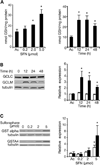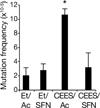Sulforaphane induces phase II detoxication enzymes in mouse skin and prevents mutagenesis induced by a mustard gas analog
- PMID: 23201461
- PMCID: PMC3804329
- DOI: 10.1016/j.taap.2012.11.020
Sulforaphane induces phase II detoxication enzymes in mouse skin and prevents mutagenesis induced by a mustard gas analog
Abstract
Mustard gas, used in chemical warfare since 1917, is a mutagenic and carcinogenic agent that produces severe dermal lesions for which there are no effective therapeutics; it is currently seen as a potential terrorist threat to civilian populations. Sulforaphane, found in cruciferous vegetables, is known to induce enzymes that detoxify compounds such as the sulfur mustards that react through electrophilic intermediates. Here, we observe that a single topical treatment with sulforaphane induces mouse epidermal levels of the regulatory subunit of glutamate-cysteine ligase, the rate-limiting enzyme in glutathione biosynthesis, and also increases epidermal levels of reduced glutathione. Furthermore, a glutathione S-transferase, GSTA4, is also induced in mouse skin by sulforaphane. In an in vivo model in which mice are given a single mutagenic application of the sulfur mustard analog 2-(chloroethyl) ethyl sulfide (CEES), we now show that therapeutic treatment with sulforaphane abolishes the CEES-induced increase in mutation frequency in the skin, measured four days after exposure. Sulforaphane, a natural product currently in clinical trials, shows promise as an effective therapeutic against mustard gas.
Copyright © 2012 Elsevier Inc. All rights reserved.
Figures


References
-
- Abel EL, Bubel JD, Simper MS, Powell L, McClellan SA, Andreeff M, Macleod MC, DiGiovanni J. Protection against 2-chloroethyl ethyl sulfide (CEES) - induced cytotoxicity in human keratinocytes by an inducer of the glutathione detoxification pathway. Toxicol Appl Pharmacol. 2011;255:176–183. - PubMed
Publication types
MeSH terms
Substances
Grants and funding
LinkOut - more resources
Full Text Sources
Other Literature Sources
Medical
Molecular Biology Databases

